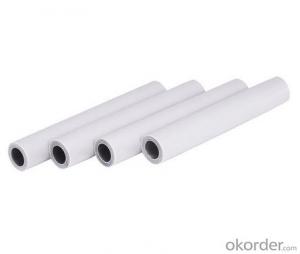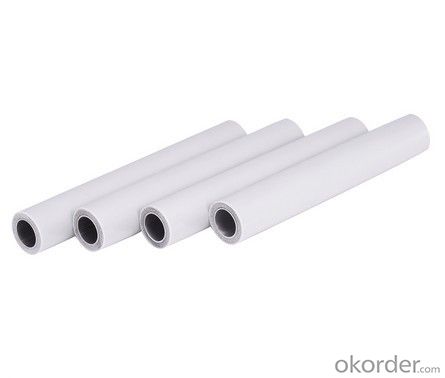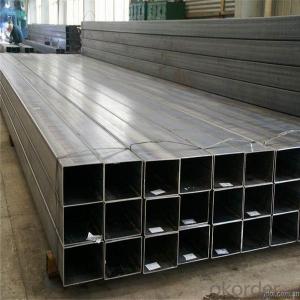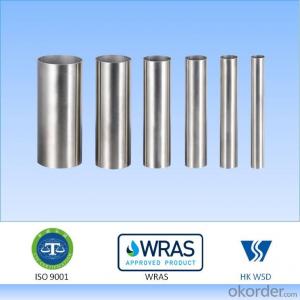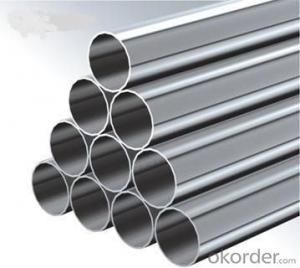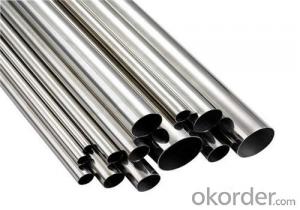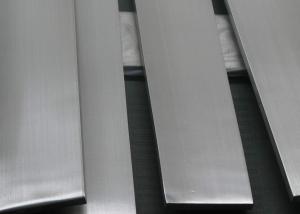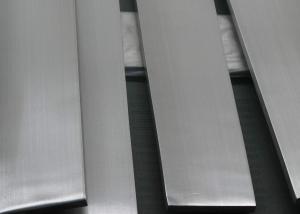Stainless Steel Insulating Pipe Stainless Steel Tube 304/316L
- Loading Port:
- Huangpu
- Payment Terms:
- TT OR LC
- Min Order Qty:
- 100 pc
- Supply Capability:
- 100000 pc/month
OKorder Service Pledge
OKorder Financial Service
You Might Also Like
Specification
WELCOME to visit our products here(^_^)
Press fitting system joins pipe without welding or bolting. The components fit by crimping through the use of a special pressing tool. An O-ring that is inserted in the fitting ends of the pipe ensures a leak-proof connection. Press fitting system is the trend of pipeline industry. It is widely used in cold and hot water supply, heating supply, fire protection, medicinal gas, industrial petroleum pipeline system etc.
For the size, now we have 3 series:
1. Out diameters: 16.0, 20.0, 25.4, 32.0, 40.0, 50.8, 63.5, 76.1, 88.9, 108.0 (GB/T 19228.2-2011)
2. Out diameters: 15.88, 22.22, 28.58, 34.0, 42.7, 48.6, 76.1, 88.9, 101.6 (JIS G3448-1980)
3. Out diameters: 15, 18, 22, 28, 35, 42, 54, 76.1, 88.9, 108 (EN 10312:2002)
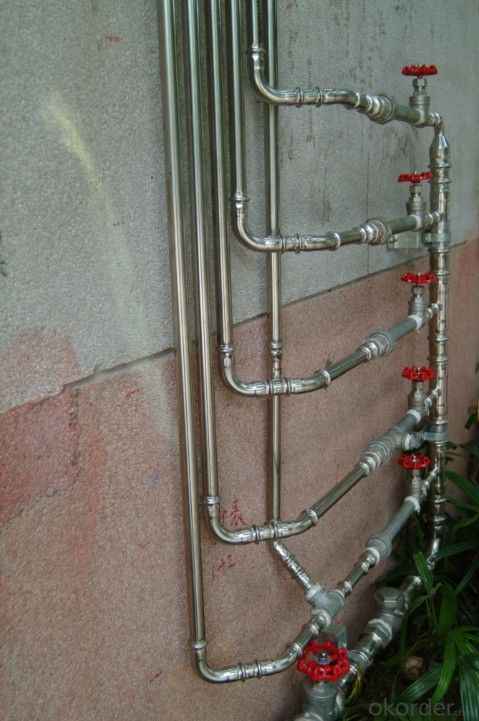
Technical information:
-- Material: Stainless steel 304 and 316L available.
-- Max working pressure 1.6MPa (equal to 232 psi), testing water pressure: 2.5MPa (equal to 362.5psi).
-- Working temperature from -20 to 110 degree centigrade (with Chlorinated butyl rubber O ring),
-- Suit medium: Cold water, hot water, compressed air, gas, oil etc
The product features as below:
1, thin wall stainless steel pipe could last for 70 years, it is the same life time with normal buildings.
2, no smell, no rusty.
3, recycle material
4, avoid welding, avoid fire dangerous.
Contact us for more details!
- Q: How do you calculate the pressure rating of stainless steel pipes?
- To calculate the pressure rating of stainless steel pipes, you need to consider several factors. First, you need to know the material properties of the stainless steel being used, such as its yield strength and tensile strength. These properties can be obtained from material data sheets or by conducting mechanical tests. Next, you need to determine the wall thickness of the stainless steel pipe. This can be measured directly or obtained from the pipe manufacturer's specifications. It is important to ensure that the wall thickness is uniform along the entire length of the pipe. Once you have the material properties and the wall thickness, you can use the appropriate formula or calculation method to determine the pressure rating. There are various codes and standards available that provide guidance on calculating pressure ratings for different types of pipes, such as the ASME B31.3 code for process piping or the ASME B31.1 code for power piping. These codes typically consider factors such as the allowable stress of the material, safety factors, and design considerations. The formulas or calculation methods provided in these codes take into account the material properties, wall thickness, pipe diameter, and other relevant parameters to calculate the maximum allowable pressure that the stainless steel pipe can withstand. It is important to note that the pressure rating of stainless steel pipes may also depend on other factors, such as the temperature of the fluid being transported, the corrosive nature of the fluid, and any potential external loads or stresses on the pipe. Therefore, it is recommended to consult the applicable codes, standards, or a qualified engineer to ensure accurate calculations and to consider all relevant factors when determining the pressure rating of stainless steel pipes.
- Q: Can stainless steel pipes be used for hygienic applications?
- Yes, stainless steel pipes can be used for hygienic applications. Stainless steel is a highly durable and corrosion-resistant material that is commonly used in industries where hygiene is of utmost importance, such as food and beverage, pharmaceutical, and biotechnology sectors. Stainless steel pipes have a smooth surface that prevents the growth of bacteria and other microorganisms, making them suitable for applications where cleanliness is crucial. They are also easy to clean and maintain, as the smooth surface allows for efficient and thorough cleaning, reducing the risk of contamination. Moreover, stainless steel pipes are non-reactive and do not release any harmful substances into the products being transported. This makes them ideal for applications where sanitary conditions are essential, such as in the production and transportation of food, beverages, and pharmaceuticals. Additionally, stainless steel pipes have excellent resistance to high temperatures, chemicals, and corrosion, ensuring the integrity of the system and preventing any contamination or leaks. They are also highly durable and can withstand harsh operating conditions, making them a reliable choice for hygienic applications. In conclusion, stainless steel pipes are suitable for hygienic applications due to their durability, corrosion resistance, smooth surface, ease of cleaning, and non-reactivity. They provide a reliable and sanitary solution for industries where hygiene is a top priority.
- Q: Can stainless steel pipes be insulated with polyetherimide?
- Polyetherimide (PEI) is an exceptional thermoplastic that exhibits remarkable thermal stability and insulation capabilities, making it a suitable choice for insulating stainless steel pipes. With its excellent resistance to heat, chemicals, and electrical conductivity, PEI can effectively insulate stainless steel pipes in diverse industries such as oil and gas, chemical processing, and aerospace. Moreover, PEI's high glass transition temperature enables it to withstand elevated temperatures without melting or deforming, further enhancing its appropriateness for insulating stainless steel pipes.
- Q: What is the maximum wall thickness for stainless steel pipes?
- The maximum wall thickness for stainless steel pipes can vary depending on the specific grade of stainless steel and the intended application. However, in general, stainless steel pipes can have a maximum wall thickness ranging from 0.065 inches (1.65 mm) to 3 inches (76.2 mm) or even more in certain cases. It is important to consult the appropriate industry standards, codes, or specifications for the specific grade of stainless steel being used to determine the maximum allowable wall thickness for a given application.
- Q: Advantages and disadvantages of PPR lined stainless steel pipe and PPR aluminium plastic pipe
- PP-R aluminium plastic steady tubePP-R aluminium plastic steady tube is a composite pipe made of PP-R tube and aluminum layer. It is based on maintaining the original PP-R tube size unchanged, using hot melt adhesive technology on the outer surface and the thickness of 0.15-0.25mm aluminum strip under high temperature organic adhesive, then coated with 0.2mm around the PP-R (or PE) protective layer produced. It has five layers of polypropylene, aluminum, gum and polypropylene. Its intermediate aluminum layer acts as a strengthening agent to combine PP-R plastic with metal. It also has flexibility of plastic pipe and rigidity of metal tube. Through the integration of aluminum layer to achieve stable mechanical properties, with higher strength and better resistance to high temperature.Advantage:PP-R steady-state aluminum plastic pipe into the PP-R tube and the metal tube in one of the advantages, at the same time with PP-R tube health and sealing and metal pipe rigidity, forming a unique superior general plastic pipe has special properties, linear expansion coefficient, impervious to physical properties of oxygen, anti UV, high strength, high temperature resistance so excellent.
- Q: What is the difference between 321 and 321H stainless steel pipes?
- The main difference between 321 and 321H stainless steel pipes lies in their carbon content and resulting mechanical properties. Both grades are stabilized austenitic stainless steels with titanium as the stabilizing element. However, 321H contains a higher carbon content compared to 321. The increased carbon content in 321H provides improved high-temperature strength and creep resistance. This makes 321H suitable for applications where elevated temperatures are involved, such as in the manufacturing of heat exchangers, furnace parts, and other high-temperature equipment. On the other hand, 321 stainless steel pipes are commonly used in applications that do not require exposure to high temperatures. They offer excellent resistance to intergranular corrosion and are frequently used in the aerospace industry, as well as for the fabrication of exhaust systems, chemical processing equipment, and other general-purpose applications. In summary, the difference between 321 and 321H stainless steel pipes lies in their carbon content and resulting mechanical properties. 321H is specifically designed for high-temperature applications, while 321 is suitable for general-purpose applications that do not require exposure to elevated temperatures.
- Q: Are stainless steel pipes resistant to sulfide stress corrosion cracking?
- Yes, stainless steel pipes are generally resistant to sulfide stress corrosion cracking due to their high chromium content which forms a passive protective layer on the surface, preventing corrosion.
- Q: Can stainless steel pipes be used in drinking water systems?
- Indeed, stainless steel pipes are suitable for utilization in drinking water systems. Being a material highly resistant to corrosion and possessing exceptional durability, stainless steel can endure the harsh elements found in water systems. It does not release any detrimental substances into the water, thus rendering it a secure option for drinking water purposes. Furthermore, stainless steel pipes are effortless to cleanse and uphold, effectively guaranteeing the quality and safety of the drinking water.
- Q: Can stainless steel pipes be used for nuclear applications?
- Indeed, stainless steel pipes are an appropriate choice for nuclear applications. The outstanding corrosion resistance, impressive strength, and capability to endure high temperatures make stainless steel a popular option in nuclear power plants. It is especially suitable for situations where the pipes encounter various nuclear substances or corrosive environments. Stainless steel pipes are employed for the transportation and containment of nuclear materials like coolant, steam, and radioactive waste. Moreover, they are utilized in the construction of nuclear reactors, where they must endure harsh conditions such as high pressure and radiation exposure. Furthermore, stainless steel pipes provide long-lasting durability and reliability, making them the preferred selection for nuclear applications.
- Q: How do stainless steel pipes perform in extreme weather conditions?
- Stainless steel pipes are known for their excellent performance and durability in extreme weather conditions. Due to their unique composition, stainless steel pipes have a high resistance to corrosion, making them ideal for use in various environments, including extreme weather conditions. In extremely cold weather, stainless steel pipes retain their strength and flexibility, unlike other materials that may become brittle or crack. This makes them suitable for applications such as oil and gas pipelines, where they can withstand low temperatures without compromising their performance. Similarly, in extremely hot weather, stainless steel pipes exhibit excellent heat resistance, preventing them from warping or deforming. This quality is crucial in industries like power generation, where high-temperature environments are common. Furthermore, stainless steel pipes have a high melting point, enabling them to maintain their structural integrity even in the presence of intense heat. This makes them resistant to fire damage, making them a safe choice for applications that require fire protection. Stainless steel pipes also have exceptional resistance to UV radiation, which can be damaging over time. This property ensures that the pipes do not degrade or weaken when exposed to direct sunlight or extreme weather conditions, making them suitable for outdoor applications. Additionally, stainless steel pipes have excellent mechanical properties, including high tensile strength and impact resistance. These qualities allow them to withstand extreme weather conditions such as high winds, heavy storms, and seismic activities without undergoing structural failures. In conclusion, stainless steel pipes are highly reliable and perform exceptionally well in extreme weather conditions. Their resistance to corrosion, high and low temperatures, UV radiation, and mechanical stress makes them a preferred choice for various industries, ensuring reliable and long-lasting performance even in the harshest environments.
Send your message to us
Stainless Steel Insulating Pipe Stainless Steel Tube 304/316L
- Loading Port:
- Huangpu
- Payment Terms:
- TT OR LC
- Min Order Qty:
- 100 pc
- Supply Capability:
- 100000 pc/month
OKorder Service Pledge
OKorder Financial Service
Similar products
Hot products
Hot Searches
Related keywords
